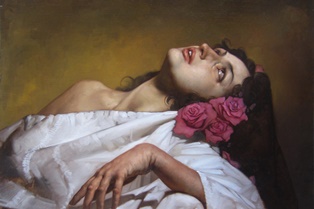
WTI Magazine #32 2014 May, 29
Author : Enrico De Iulis Translation by:
There is an artist in Italy who has earned more than any other, in this first part of the twenty first century, the reputation of "child prodigy": the painter Roberto Ferri.
Already a decade ago, when he was in his early twenties, his name was big among the Roman contemporary galleries.
His formation follows a natural process from art high school to the Academy of Fine Arts in Rome with a degree in Set Design with Gaetano Castelli, perhaps the most famous scenographer in the history of Italian television (almost all versions of the stage of the Ariston Theatre in the Festival of Sanremo of all these years have been designed and made by him).
There is a lot of theater in the paintings of Ferri, especially the off theater where the antlers are skinny, the lights are directional and the scenery simply disappeared for lack of space or funds: only subjects narrating stories with their bodies in the foreground on dark and neutral backgrounds.
But which stories? And what style? They are representations of the classic myths with a modern twist, through allusive titles but seen with a new lens, more contemporary in content and dream-like in the exposition. But there's more: Ferri's style liberally steals from Caravaggio's use of light, from the construction of the excited baroque design and the mannerist anatomical contortions of the mid-sixteenth century.
Narrated this way, it would seem just a good copy of the current artistic ideas that design after the Council of Trento could be found in every Roman painting shop, but of course this is not the case.
With these cultural roots, the result of the works of Ferri is still contemporary more than ever; bodies merge with machinery, metals, or musical instruments, creating a "steampunk" atmosphere framed in baroquesque stages. It is a kind of cabinet of wonders in which mythological figures come to life thanks to mechanical clutch, to the absence of gravity or to the multiplication of bodies.
When you dream, there are passages of space and time that are not framed in the memory of those who remember the dream. Well, those passages just seem to be the subject of Ferri's paintings, the stop to an image which is disturbing because it concerns a metamorphic body, a cyborg in the atmosphere of Caravaggio or in a Derek Jarman film.
When, more than ten years ago, Ferri's works began to be known and appreciated, we were still not used to the images of human anatomy and metal objects merged into a single figure, except maybe in the comic strip of some mutant superheroes.
Ferri was ahead of his time: after him television and cinema have produced several films and TV series with the characteristics that we find in the colors and in the subjects of the painter from Taranto.
Beautiful works that continue to improve, production after production, and that strengthen the figurative Italian tradition to contemporary "steampunk" taste.



